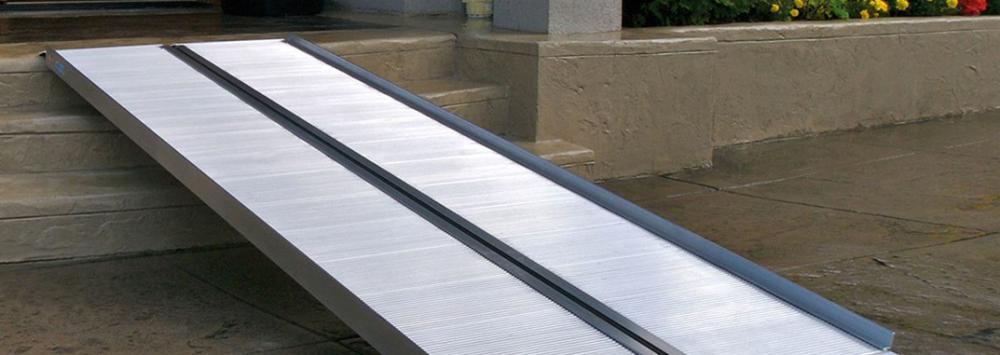
Which Wheelchair Ramp Is Right For You?
Sally Madeley-Carr, OT21 Jan 2021
According to NHS statistics, there are over 1.2 million people who use wheelchairs in the UK. Of that total, around 800,000 use them regularly.
As any wheelchair user will tell you, the environment can seem an unaccommodating place when you're rolling rather than walking.
While various changes to government regulations have led to improvements over the last 25 years, ramp or lift access is still under-supplied in both public and private premises.
Often the provision of simple ramps is absent or inadequate. This means there remains a high demand from wheelchair users or their carers to use portable ramps which they carry with them.
Around the home environment, most wheelchair users install permanent or semi-permanent ramps. This helps negotiate obstacles they need to overcome on a daily basis.
There are numerous types of ramps which some may need to solve specific problems. Here, we'll run down the most common and practical of these key mobility aids.
Threshold ramps
Doorways often have a raised lip on the floor between the frames, or sometimes even a small step.
While these obstacles are usually quite low, they still require some form of ramp to get over them.
Threshold ramps are designed specifically for this purpose, creating a sloped surface on both sides of the threshold, allowing a wheelchair to roll up and over without impediment.
Those in Essential Aids threshold ramps section are made from either synthetic rubber, fibreglass or aluminium.
Some of our ramps sit flush with the top of the step which is being ramp over, with another identical ramp usually being required on the other side, unless the floor is even on one side.
Synthetic rubber is a great material for these low ramps. It is relatively heavy and high friction, meaning will stay in place of its own accord, without requiring fixings.
It is also non-slip, making it a safe option for people walking across the threshold.
Depending on the specifics of the threshold concerned, you may need to fit this style of threshold ramp on either side of the obstruction.
Another similar design is the popular Outdoor Fibreglass Threshold Ramp. As the name suggests, it is made of non-corrosive fibreglass, making it suitable for the garden or elsewhere out in the elements.
It has a non-slip, textured surface, helping to reduce the chance of any slips.
An example of the aluminium option is the Threshold Bridging Ramp. This provides a complete bridge from one side of the threshold to the other.
Available in two elevation sizes, its design means that it is able to accommodate different floor heights on either side.
Rather than a textured non-slip surface, this type of ramp has a raised pattern on the aluminium itself. As it is aluminium, it is rigid, non-rusting and relatively lightweight, making it easy to remove and store as required.
All the Essential Aids threshold ramps are light enough in weight to be easily installed and removed as necessary.
They provide an inexpensive means of retaining access around the home for wheelchairs, rollators, wheeled walking frames or simply for those unable to overcome small obstacles, even on foot.
Folding ramps
Essential Aids' folding wheelchair ramps section has a variety of high quality products which fold down for easy storage or transportation.
This type of ramp is usually larger than a threshold unit, but in most cases is similarly lightweight.
The objective with folding ramps is that they are light and easy to carry, as well as being strong and adaptable to the steps or other obstacles they need to bridge.
It is also important that they fold down to a manageable size, as most will need transportation in the boot of a car.
Available in lengths of up to 10ft, these ramps typically fold in the middle. Some separate into two halves, with each half itself folding in half once more.
Remember, the larger the obstacle, the longer the ramps need to be. There is more information about the length of ramp required for a given height, further down this page.
Suitcase ramps
Effectively a version of folding models, suitcase ramps got their name for their collapsed states similarity to a suitcase.
The two halves of the ramp fold together in the middle and handles on one side provide facility to carry the two parts as a suitcase.
Essential Aids supplies numerous sizes of suitcase ramp, ranging from those just 2ft in length, right up to 7ft.
Most have non-slip surfaces on the rolling side.
Channel ramps
Folding channel ramps are another option in this category. Channel ramps come in two sections, and must be aligned accurately when in use.
Each section is narrow, with raised edges, creating a channel through which the wheels on one side of the wheelchair or mobility scooter roll. The raised lips prevent the wheels slipping off to either side.
The folding versions are hinged in the centre, meaning that each section is usually light in weight and easy to transport in the boot of a car.
This type of ramp is frequently used when loading electric wheelchairs and mobility scooters on to larger vehicles with adequate internal capacity.
Usually made from aluminium, channel ramps have either a milled pattern or a grained plastic surface on the rolling surface. This improves friction and reduces the chance of the wheels slipping.
Modular ramps
Being extremely lightweight, installing modular ramps as quick and easy. Made from aluminium, they have separate pieces which fit together lego-style, which when fitted together can produce a ramp to the required height.
Suitable for permanent or temporary purposes, they are usually used for thresholds or other low obstacles.
They usually have a perforated design, giving the advantage that water is able to flow through and away.
Telescopic ramps
A variation of channel ramps, telescopic ramps can be collapsed to a small size, making them ideal for transportation and storage.
As the name suggests, these ramps have sections which slide in on themselves when not in use.
As with other channel ramps, the width of each unit is usually quite narrow - at the most about a foot wide.
Roll-up wheelchair ramps
Part of the Essential Aids range is the Roll Up Wheelchair Ramp. This is a popular choice because of its portability and versatile nature.
For transportation, it rolls up and fits inside its own carry bag, which can be slung over your shoulder or hung on the back of a wheelchair.
Its clever design means that despite its flexibility, once rolled out it becomes rigid.
At nearly a metre in length once unrolled, the Roll Up ramp is among our most practical mobility aids.
Aluminium wheelchair ramps
Over the last 30 years, aluminium has become the number one choice in the manufacture of wheelchair ramps, especially portable ones.
It is relatively light in weight, non-corrosive, rigid and cost effective.
Previously, steel was used for ramps because of its great strength and rigidity. Unfortunately the downside was in its heavy weight and tendency to rust.
The first of these factors meant that it was never really suitable for portable ramps which need quick and easy installation, deinstallation or transportation.
Before aluminium was widely available at a reasonable price, fibreglass became a viable option.
This was, however, largely superseded by aluminium in the 1990s and on to this day.
Permanent fixed ramps
If you know exactly where you will need a ramp and that the space is available for a permanent installation, you might think about having a bespoke one built.
Carpenters can create robust wooden ramps, complete with handrails and non-slip surfaces, made to measure.
Other tradesmen can build even more substantial ramps from moulded concrete or cement.
These have the benefit of being super stable but obviously are only suitable for certain situations.
Which length of ramp will you need?
For using a wheelchair, any ramp needs to have a minimum gradient of 1:6 to be safe. This makes for a relatively shallow incline.
In practical terms, the requirement is that for each foot of rise (otherwise known as load height;) a ramp length of six feet is required.
Heavier loads like mobility scooters which also have a low ground clearance, need an even shallow gradient of 1:8.
So for using scooters, the one-foot load height requires a ramp length of eight feet.
When choosing your ramp or ramps, you need to take account not just of the gradient required but also the space needed to lay it safely. In practical terms, this is often much greater than people anticipate.
Consider too that any threshold ramps need to be adequately wide for the wheelchair or scooter, but narrow enough for the doorway it crosses.
Summary
Whether you need ramps for a wheelchair, mobility scooter, rollator, wheeled walking frame or other wheeled mobility aids, access ramps are an important consideration.
Thoroughly measuring and assessing any obstacles which you might need to use ramps to overcome is the first stage in the process.
Cross check the specifications at Essential Aids with your requirements before committing to a particular ramp.
The product information on each of our units shows in adequate detail all the relevant measurements and load-bearing capacity.

Sally Madeley-Carr, OT
Sally qualified as an Occupational Therapist in 1996 and is a well-respected professional in the field of rehabilitation equipment and living aids. She has worked in private practice and within the NHS, developing a broad experience with adults and children. Click here for Sally's registration with the Health and Care Professions Council. The HCPC regulates health, psychological and social work professionals in the UK.